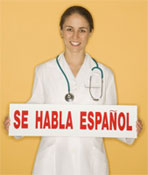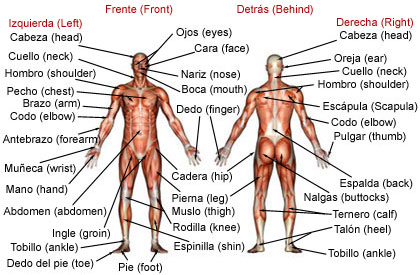
The US Census Bureau released a report in March of 2011
revealing that between 2000 and 2010 the US Hispanic
population grew 43 percent from 35.3 million to 50.5
million. Its share of the total population rose from 13 to
16 percent. That accounts for more than half the total US
population growth since 2000. Given this growth in the
Hispanic population, it may not be uncommon to encounter
patients who either speak limited English or no English at
all in the physical therapy setting.
As a physical therapist who has taken Spanish in both high
school and college, I have found this added skill invaluable
when working with Spanish speaking patients who present with
a language barrier. Having some ability to communicate with
these patients not only makes working with and treating
these patients easier, but further establishes a level of
comfort and trust when developing the patient & therapist
relationship. Below are some medical Spanish tips which I hope therapists
will find helpful when communicating with Spanish speaking
patients when conducting an initial evaluation.
Click Here for pdf version of article
Subjective:
Me llamo (your name here). – My name is (your name
here).
Soy su terapeuta
físico. – I am your physical
therapist
¿Cómo estás? – How are you?
¿En que trabaja? - What do you do for
a living?
¿Qué occurió? - What happened?
Le practicaron una cirugía. – You had surgery.
¿Te caíste? - Did you fall?
¿Tuviste un accidente? - Were you in an
accident?
¿Cuándo occurió? - When did it happen?
¿Por cuánto tiempo ha tenido el problema? - How long have
you had the problem?
¿Ha ocurrido antes en el pasado? – Has it happened
before in the past?
¿En dónde se lastimó? - Where did you get hurt?
¿Tiene dolor? – Do you have pain?
¿Dónde le duele? – Where does it hurt? (see Figure 1)
Elija el dolor. – Point to the pain. (see Figure 1)
Figure 1 - Anatomical Parts in Spanish
|
 |
Describa su dolor. – Describe your pain.
¿Es agudo (sharp), sordo (dull), adolorido (achy), punzante
(throbbing), quemante (burning), súbito (shooting), punzante
(stabbing)? – Is the pain sharp, dull, achy, throbbing,
burning, shooting, stabbing?
¿Cuánto dolor tiene usted en una escala de cero a diez
donde cero es la ausencia de dolor y diez es el dolor más
fuerte? - How much pain do
you have on a scale of 0-10 with 0 being no pain and 10
being the worst pain?
¿Tiene algún entumecimiento u hormigueo? - Do you have any
numbness or tingling?
¿Le duele al sentarse (sit), pararse (stand), caminar
(walk), agacharse (bend), levantar (lift), se agacha
(squat), transportar (carry), subir escaleras (climb
stairs)? - Does it hurt to sit, stand, walk, bend, lift,
squat, carry, climb stairs?
¿Qué alivia su dolor?? - What gives you relief?
¿Es su (body part ie. espalda) rígida? Is your (body part –
see Figure 1 ie. back) stiff?
¿Qué son sus objetivos con la terapia? - What are your goals
for therapy.
Objective:
Parese por favor. - Please sit up.
Siéntese por favor. – Please sit down.
Acuéstese sobre su espalda. – Lie down on you back.
Acuéstese de frente. – Lie on your front.
Boca abajo – Face down
Boca arriba – Face up
Voltee – Turn over to your other
side.
Dolor - Pain
¿Le duele cuando hago esto? – Does it hurt when I do
this?
Dime cuándo duele. – Tell me when it hurts.
Levante esto (body part ie. brazo). - Raise this
(body part –see Figure 1 - arm)
Mueva su (body part ie. brazo). - Move your (body
part –
see Figure 1 – arm)
Me gustaría examinar su fuerza. – I would like to
test your strength.
Me gustaría poner a prueba su rango de movimiento. –
I would like to test your range of motion.
Mantenga esta posición. – Hold this position.
No me deje moverlo. – Don’t let me move you.
Manténgalo derecho. – Keep it straight.
Inclínese hacia adelante – Bend forward
Doblar hacia atrás – Bend backward
Doble a la izquierda – Bend to the left.
Doble a la derecha – Bend to the right
Gire a la derecha – Turn to the right
Gire a la izquierda – Turn to the left
Resísteme – Resist me
Más Fuerte – Harder
Relájese – Relax
Haga este ejercicio. – Do this exercise.
Camine para mí. – Walk for me.
Sigue lo que hago. – Follow what I do.
Aquí – here
Tome un descanso. - Take a break.
Assessment:
Usted tiene debilidad. – You have weakness.
Usted tiene la rigidez. – You have stiffness.
Usted tiene los músculos tensos. – You have tight
muscles.
Usted se esguinzo en un ligamento. – You sprained a
ligament.
Usted se desgarró un ligamento. You tore a ligament.
Usted se desgarró un músculo. – You pulled a muscle.
Usted tiene problemas de equilibrio. – You have
balance problems.
Usted tiene tendinitis. – You have tendonitis.
Usted tiene una hernia discal. – You have a slipped
disc.
Usted tiene problemas con su mecánica. - You have
problems with your mechanics.
Usted tiene problemas con su postura. – You have
problems with your posture.
Usted tiene artritis. – You have arthritis.
Usted tuvo un derrame cerebral. – You had a stroke.
Le practicaron una cirugía. – You had surgery.
El nervio se irrita. – The nerve is irritated.
Plan:
Me gustaría que vinieras a la terapia dos veces por
semana durante cuatro semanas. – I would like you to
come to therapy 2 x a week for 4 weeks.
Uno – 1, Dos – 2, Tres –3, Cuatro – 4, Cinco – 5
Usted recibirá tratamiento, el cual incluye: –
You will be seen for treatment including:
- Ejercicio terapéutico – Therapeutic exercise
- Fortalecimiento – Strengthening
- Estabilización – Stabilization
- Estiramiento – Stretching
- El rango de movimiento – Range of motion
- Entrenamiento de la postura – Postural training
- El entrenamiento funcional – Functional training
- Masaje – Massage
- Manual de Terapia – Manual therapy
- Conjunto movilizaciones – Joint Mobilizations
- Balance de la formación – Balance training
- Modalidades - Modalities
Last revised: May 15, 2011
by Chai Rasavong, MPT, MBA








